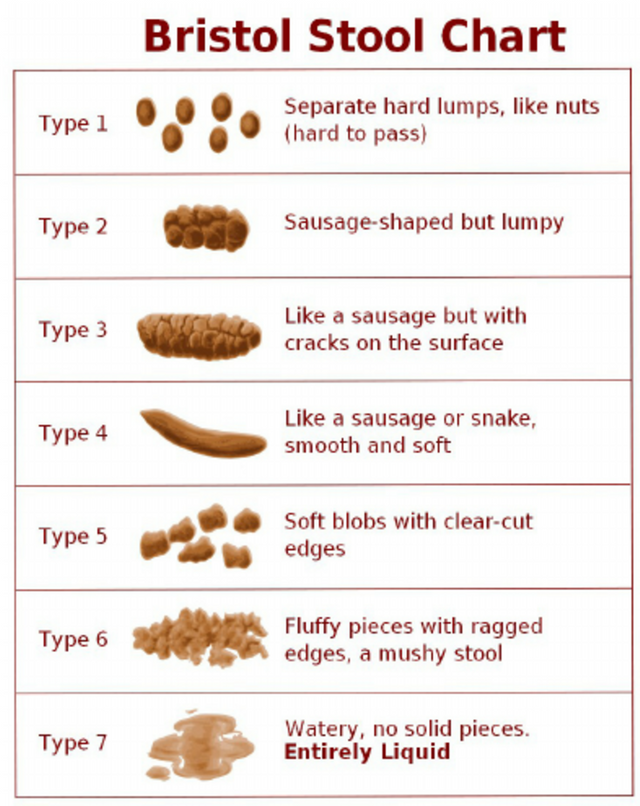
The shape, texture, color and smell of your feces along with the frequency of bowel movements, can help you discover if you have a health problem.
Know the different types of stools and what each of them indicates.
Human beings expel an average of between four and five tons of feces throughout their lives. The frequency of intestinal emptying varies from one person to another, and it is considered normal to defecate three times a day and three times a week.
However, if there is a sudden change in bowel movements it is advisable to consult the doctor, because there are many factors that can alter this habit-from a change in diet or sleep patterns, to a trip, exercise, pregnancy, the consumption of certain medications, or a stress situation, and also the presence of various diseases.
The shape, texture and color of stool and not just the frequency of bowel movements or a sudden change in defecation patterns can help us discover if we have a health problem or if the diet we consume is inadequate, or suffer an allergy or food intolerance.
In fact, to check which stools are in the range of normal, and which may indicate an abnormality in the intestinal transit, or even the presence of a disease, there is a table, called Bristol Stool Scale , which classifies them in seven different types, according to their shape and consistency.
Types of stools and problems that they may indicate: The Bristol Scale
The fecal matter contains approximately 75% water and the rest of its content consists of fiber, cells, living and dead bacteria and mucus. The Bristol scale describes seven different types of stools :

Types 3, 4 and 5 represent the shape and texture that stools should have. If they are type 1 or 2, they usually indicate constipation and it is necessary to consult with the doctor to find out their possible causes , which are highly variable-from a lack of dietary fiber or water in the diet, to sedentary lifestyle or thyroid disorders.
The causes of diarrhea (types 6 and 7) can also be very diverse, from a flu virus that affects the stomach, to a lactose intolerance , or a disease like irritable bowel syndrome.
Are the color and smell of your stools worrisome?
Other characteristic of your stool which you should take note of is its color and smell. Thus, although we all know that it is normal for excreta to smell bad, if they are really smelly it could be a sign of some health problem such as celiac disease, malabsorption disorder, chronic pancreatitis , or Crohn's disease among many others.
Therefore, if it gives off a very strong and persistent unpleasant smell, it is necessary to consult with the doctor.
With regard to the color of the stool , it depends on the food we eat and the amount of bile it contains, which means that the color of the stool should reveal a combination of the colors of the food and the bile. We explain what each of the most common tonalities can mean:
MAROON . The various shades of brown are generally considered healthy, and indicate that the diet the individual consumes is balanced.
GREEN . A high consumption of green leafy vegetables, such as spinach, can dye stools with this color; however, it can also mean that food quickly crosses the large intestine, which prevents the bile from completely decomposing, so if the situation continues, you should tell your doctor.
RED . It may be due to the intake of food, medicines, or food colorings of that color, in which case they should return to their normal tone when they are no longer consumed. If it is a bright red color, it could be a sign of intestinal bleeding , or the presence of blood from a wound or hemorrhoids and is also a reason for medical consultation.
YELLOW . It can be due to several causes, one of them is giardiasis , an infection caused by a parasite called Giardia , which is naturally present in the intestine, but if its concentration increases for some reason it can cause diarrhea of this color. If in addition to yellowish the stools have a greasy appearance and an unpleasant odor, it can be malabsorption or celiac disease.
CLEAR . If the stool is very clear it could be due to a deficiency of bile, and indicate serious health problems such as a biliary obstruction, hepatitis, cirrhosis and pancreatic disorders.
The iron supplements darken the tone of the stool, but if it is lacking the black color can indicate an excess of bile to bleeding in the upper gastrointestinal tract, including the stomach.
Although this isn't the most pleasant topic to read about, it's valuable information, and may be of some use to individuals seeking answers to unexplained bowl/fecal problems.
I noticed your account was inactive for some time, and you just started posting again. I hope you will continue posting quality content like this, as we need more quality content providers.
I hope to see more from you @bleedingpen, nice job :)
Downvoting a post can decrease pending rewards and make it less visible. Common reasons:
Submit
Thanks for the motivation and yes knowing that folks like you read and appreciate my post will keep me posting! Thanks once more
Downvoting a post can decrease pending rewards and make it less visible. Common reasons:
Submit
Congratulations @bleedingpen! You have completed the following achievement on the Steem blockchain and have been rewarded with new badge(s) :
Click here to view your Board of Honor
If you no longer want to receive notifications, reply to this comment with the word
STOPDownvoting a post can decrease pending rewards and make it less visible. Common reasons:
Submit